We returned from a warm vacation week to a skating rink playground, so we made good use of it. On Monday we played hockey with brooms and ice chunks. Go Big Green! Go Boston Bruins! With a light dusting of snow the following day, we skated around with our snow shovels and made paths for the vehicles. After a rainy recess Wednesday some streams wound through the ice, making for a fun muddy Thursday, then back to ice skating on Friday. The trucks were well used, though the wheels on the vehicles kept jamming up with packed snow, a frustration for the drivers. We attempted to come to a solution, but we didn’t have chains for toy truck tires. Requests for chase and tag were denied to eliminate the hazard of running on ice, so the children took to giving sled rides and shoveling to expend their energy.

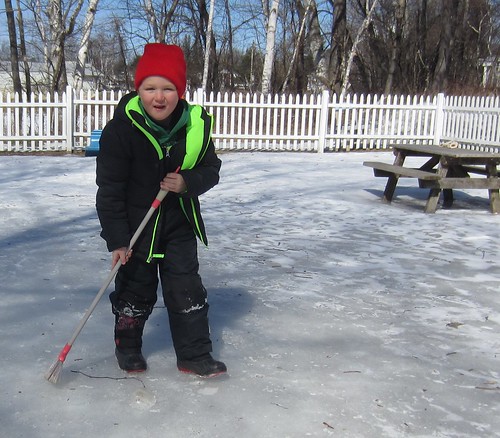



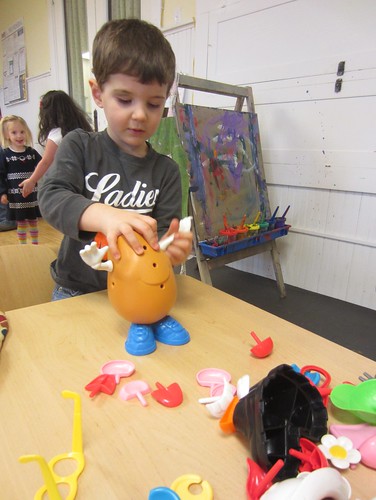









 On Monday morning we noticed that one of the two butterflies in our tank had emerged from its’ chrysalis. We were so excited to see it, and the children loved watching it throughout the week. They pretended to be caterpillars hatching out of eggs, crawling around eating green leaves, hanging upside down and breaking through their skin to become chrysalises, then emerging into butterflies flying around the room. It was a very exciting week! Sadly, it was much too cold to let it out into nature, so we made some sugar water mixture for it. Unfortunately, it was not sufficient to keep it alive, so our butterfly did not survive through Friday.
On Monday morning we noticed that one of the two butterflies in our tank had emerged from its’ chrysalis. We were so excited to see it, and the children loved watching it throughout the week. They pretended to be caterpillars hatching out of eggs, crawling around eating green leaves, hanging upside down and breaking through their skin to become chrysalises, then emerging into butterflies flying around the room. It was a very exciting week! Sadly, it was much too cold to let it out into nature, so we made some sugar water mixture for it. Unfortunately, it was not sufficient to keep it alive, so our butterfly did not survive through Friday.


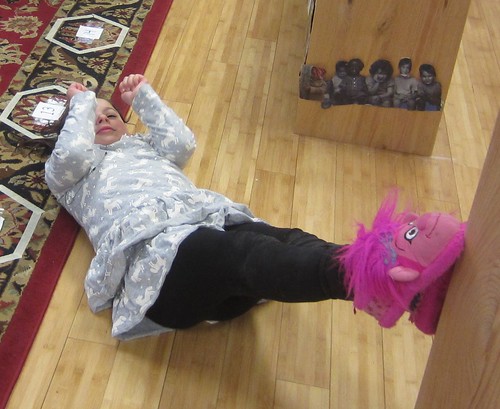
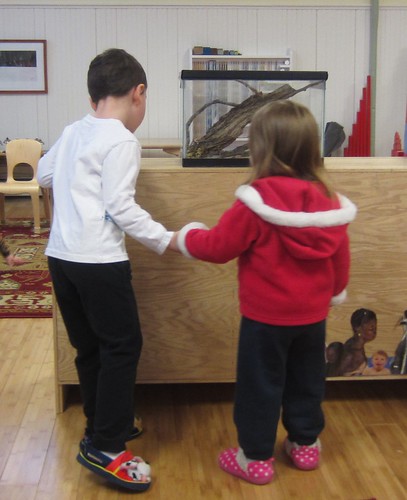

 Pointillism was introduced for art on Monday, particularly the French artist Paul Signac, who, together with Georges Seurat, developed this painstaking form of painting. The children observed several paintings, noticing the small dots or slashes of color that were used to create the pictures, then they used Q-tips to make their own pointillism art. Pointillism was introduced to the group on Tuesday, and children continued to create beautiful works of art throughout the week.
Pointillism was introduced for art on Monday, particularly the French artist Paul Signac, who, together with Georges Seurat, developed this painstaking form of painting. The children observed several paintings, noticing the small dots or slashes of color that were used to create the pictures, then they used Q-tips to make their own pointillism art. Pointillism was introduced to the group on Tuesday, and children continued to create beautiful works of art throughout the week.
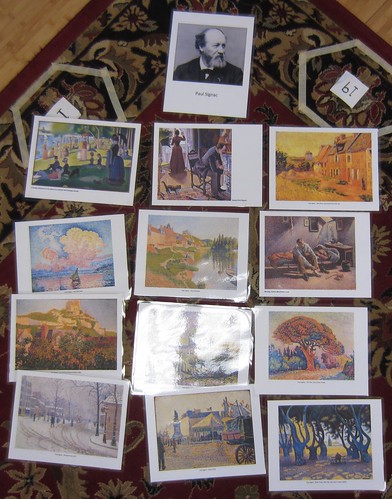

 As Monday was a play date day, the students had fun on their monthly visit to the library with Tammy, where they played school bus, trains, play dough, and doll house.
As Monday was a play date day, the students had fun on their monthly visit to the library with Tammy, where they played school bus, trains, play dough, and doll house.


 We began our study of the continent of Europe. We examined some items from Europe, including some wooden clogs from the Netherlands, a marionette puppet, a model of the Eiffel Tower, some Scottish tartan fabrics, and a Euro – the money used in most of Europe. Susan brought additional items to share on Wednesday, including a 100 year old nutcracker in the shape of an old woman, a Scottish kilt, a knit sweater from the Netherlands, and several nesting dolls from various countries, including Poland, Russia, Lithuania, and Romania (I think). The children loved trying on the shoes and clothes, playing with the marionette, and taking apart and reassembling the nesting dolls.
We began our study of the continent of Europe. We examined some items from Europe, including some wooden clogs from the Netherlands, a marionette puppet, a model of the Eiffel Tower, some Scottish tartan fabrics, and a Euro – the money used in most of Europe. Susan brought additional items to share on Wednesday, including a 100 year old nutcracker in the shape of an old woman, a Scottish kilt, a knit sweater from the Netherlands, and several nesting dolls from various countries, including Poland, Russia, Lithuania, and Romania (I think). The children loved trying on the shoes and clothes, playing with the marionette, and taking apart and reassembling the nesting dolls.






 We played an over, beside, under game with the small globe. Each child took a turn holding the globe either beside, over, or under them while we chanted, “My friend . . . is beside/over/under the globe.” Several children began to make books in which they drew pictures of their friends beside/over/under items then wrote the names, the position, and the item.
We played an over, beside, under game with the small globe. Each child took a turn holding the globe either beside, over, or under them while we chanted, “My friend . . . is beside/over/under the globe.” Several children began to make books in which they drew pictures of their friends beside/over/under items then wrote the names, the position, and the item.

 The children took down the Amazon rain forest. They did some brainstorming and took a vote about what to put in dramatic play next. Out of their five suggestions, they decided on a Market, so they got underway setting that up and playing in it. There is a bakery, and several stalls selling fruit, vegetables, dairy products, and boxed foods. Sign makers were busy pricing out items and posting them, bakers were busy baking, shoppers were busy making wallets to hold their money and selecting items to purchase, and cashiers were busy ringing up the items.
The children took down the Amazon rain forest. They did some brainstorming and took a vote about what to put in dramatic play next. Out of their five suggestions, they decided on a Market, so they got underway setting that up and playing in it. There is a bakery, and several stalls selling fruit, vegetables, dairy products, and boxed foods. Sign makers were busy pricing out items and posting them, bakers were busy baking, shoppers were busy making wallets to hold their money and selecting items to purchase, and cashiers were busy ringing up the items.





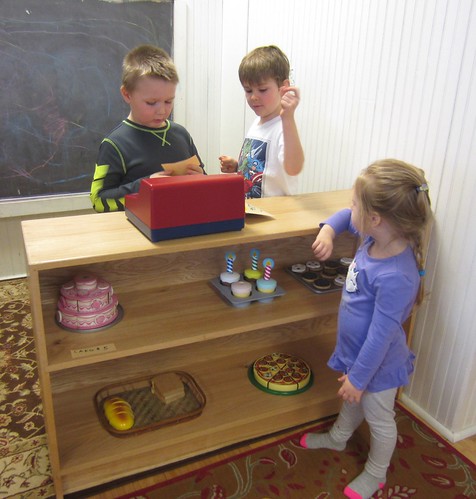

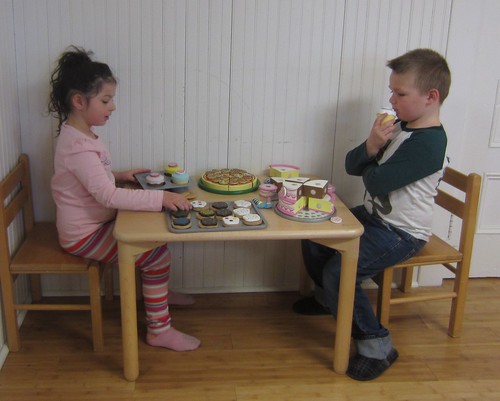
 On Thursday morning we had a special visitor, Debra Chen, who did a fun experiment with us. First we discussed what it means to be sick and how we feel when we are sick. The children had a lot to share about that! Then she explained what an experiment is. We then did an experiment. She “sneezed” into her hand three times, using a spray bottle with colored water to sneeze, then she shook hands with the student beside her, who shook hands with someone else, who shook hands with someone else, who shook hands with someone else. We observed that the germs from the sneeze had spread to all the children who shook hands. Debra then washed her hands and shook hands with another student, and we observed that the “germs” had all been washed away, so they did not transfer to anyone else. The children were more careful to scrub well with soap and water and count to twenty before rinsing before snack and after nose wiping!
On Thursday morning we had a special visitor, Debra Chen, who did a fun experiment with us. First we discussed what it means to be sick and how we feel when we are sick. The children had a lot to share about that! Then she explained what an experiment is. We then did an experiment. She “sneezed” into her hand three times, using a spray bottle with colored water to sneeze, then she shook hands with the student beside her, who shook hands with someone else, who shook hands with someone else, who shook hands with someone else. We observed that the germs from the sneeze had spread to all the children who shook hands. Debra then washed her hands and shook hands with another student, and we observed that the “germs” had all been washed away, so they did not transfer to anyone else. The children were more careful to scrub well with soap and water and count to twenty before rinsing before snack and after nose wiping!
 String instruments were introduced, specifically those invented in Europe, including the lap harp/zither from Germany, the violin from Italy, the guitar from Spain, the ukulele (from Hawaii/US but invented by a man from Portugal), and the piano from Italy. We learned that they make music when the strings are strummed, plucked, bowed, or struck. We examined each instrument and took turns playing the guitar, ukulele, and piano. We opened the front of the piano and watched the hammer mechanism strike the strings as we pressed the keys.
String instruments were introduced, specifically those invented in Europe, including the lap harp/zither from Germany, the violin from Italy, the guitar from Spain, the ukulele (from Hawaii/US but invented by a man from Portugal), and the piano from Italy. We learned that they make music when the strings are strummed, plucked, bowed, or struck. We examined each instrument and took turns playing the guitar, ukulele, and piano. We opened the front of the piano and watched the hammer mechanism strike the strings as we pressed the keys.



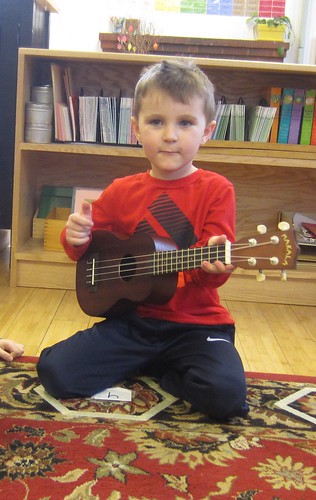
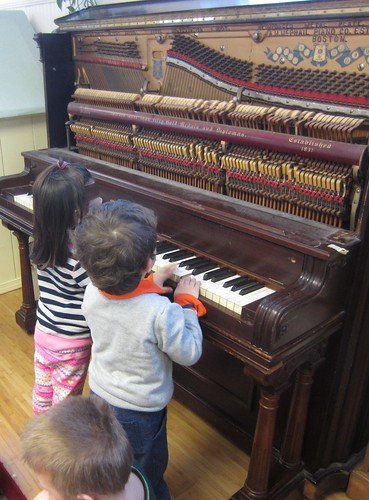











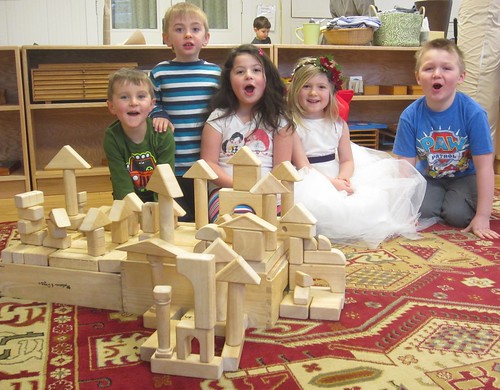







 For science on Friday we studied insects. The children each selected an insect figure to observe. They noted that some had wings, they all had eyes, they all had six legs, and some were fuzzy. We read the book About Insects and learned that all insects not only have six legs, but three body parts – the head, thorax, and abdomen. We also learned that they have exoskeletons and hatch from eggs. We looked at our chart and recognized that all animals except for mammals (and a select few reptiles, amphibians, fish, and insects) hatch from eggs. We talked about some animals that we might often refer to as insects, but are not, such as spiders, worms, centipedes, and snails, because they do not have six legs and three body parts. We learned that insects go through metamorphosis, like amphibians, and looked at some models of insect metamorphosis, including a butterfly, ladybug, and honey bee. We also discussed what a bug is. We read the book Bugs Are Insects and learned that bugs are a specific kind of insect that have triangular shaped heads and beak like mouths and that despite their name, ladybugs are NOT bugs, they are beetles!
For science on Friday we studied insects. The children each selected an insect figure to observe. They noted that some had wings, they all had eyes, they all had six legs, and some were fuzzy. We read the book About Insects and learned that all insects not only have six legs, but three body parts – the head, thorax, and abdomen. We also learned that they have exoskeletons and hatch from eggs. We looked at our chart and recognized that all animals except for mammals (and a select few reptiles, amphibians, fish, and insects) hatch from eggs. We talked about some animals that we might often refer to as insects, but are not, such as spiders, worms, centipedes, and snails, because they do not have six legs and three body parts. We learned that insects go through metamorphosis, like amphibians, and looked at some models of insect metamorphosis, including a butterfly, ladybug, and honey bee. We also discussed what a bug is. We read the book Bugs Are Insects and learned that bugs are a specific kind of insect that have triangular shaped heads and beak like mouths and that despite their name, ladybugs are NOT bugs, they are beetles!




European Adventures Are Underway
March 11, 2017
